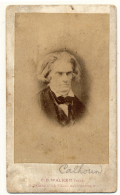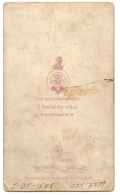site search
online catalog
CDV OF JOHN C. CALHOUN

$125.00 SOLD
Quantity Available: None
Item Code: 1138-1588
Bust view of older John Calhoun with usual wild hair. Image is clear with good contrast. The mount Features a pencil "Calhoun" at the bottom along with photographer's imprint. Photographer's backmark, C.B. Walker, Bayswater, Some light soiling overall.
John Caldwell Calhoun (March 18, 1782 – March 31, 1850) was an American statesman and political theorist from South Carolina who held many important positions including being the seventh vice president of the United States from 1825 to 1832, while adamantly defending slavery and protecting the interests of the white South. He began his political career as a nationalist, modernizer, and proponent of a strong national government and protective tariffs. In the late 1820s, his views changed radically, and he became a leading proponent of states' rights, limited government, nullification, and opposition to high tariffs. He saw Northern acceptance of those policies as a condition of the South remaining in the Union. His beliefs and warnings heavily influenced the South's secession from the Union in 1860–1861.
Calhoun began his political career with election to the House of Representatives in 1810. He served as Secretary of War under President James Monroe. Calhoun was vice president and served under John Quincy Adams and continued under Andrew Jackson.
Calhoun served as Secretary of State under President John Tyler from 1844 to 1845. He then returned to the Senate, where he opposed the Mexican–American War, the Wilmot Proviso, and the Compromise of 1850 before he died in 1850.
Calhoun died at the Old Brick Capitol boarding house in Washington, D.C., on March 31, 1850, of tuberculosis, at the age of 68. He was interred at St. Philip's Churchyard in Charleston, South Carolina. During the Civil War, a group of Calhoun's friends were concerned about the possible desecration of his grave by Federal troops and, during the night, removed his coffin to a hiding place under the stairs of the church. The next night, his coffin was buried in an unmarked grave near the church, where it remained until 1871 when it was again exhumed and returned to its original place.
This is from the late William Turner collection. [jet] [ph:L]
~~~~~~~~~~~~~~~~~~~~~~~~~~~~~~~~~~~
THIS ITEM, AS WITH ALL OTHER ITEMS AVAILABLE ON OUR WEB SITE,
MAY BE PURCHASED THROUGH OUR LAYAWAY PROGRAM.
CLICK HERE FOR OUR POLICIES AND TERMS.
THANK YOU!
Inquire About CDV OF JOHN C. CALHOUN
For inquiries, please email us at [email protected]
Most Popular
Historical Firearms Stolen From The National Civil War Museum In Harrisburg, Pa »
Theft From Gravesite Of Gen. John Reynolds »
Selection Of Unframed Prints By Don Troiani »
Fine Condition Brass Infantry Bugle Insignia »
Wonderful Condition Original Confederate-Manufactured Kepi For A Drummer Boy Or Child »
featured item
5th NEW YORK NATIONAL GUARD COMPANY E FLANK MARKER
This very attractive blue silk marker with gold fringe and embroidered unit designation comes with a 1995 letter from flag authority Howard Madaus, a 2004 treatment report by Textile Preservation Associates, the well-known and highly respected… (1179-014). Learn More »
site search
Upcoming Events
The shop is closed Jan. 2nd thru Jan. 16th for inventory; we will still be available by phone &… Learn More »




